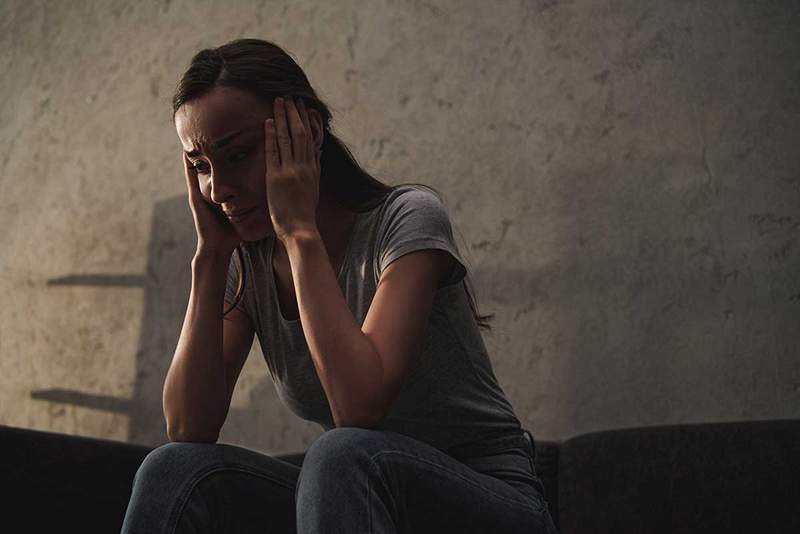Sitting depression is not enough is a real disease

- 3350
- 321
- Frederick Cormier
Who has not heard when we are sad a "want", "you are no longer sad", "there are people who are worse than you", "you have everything, you should not be like this", "you want to manipulate the situation". Possibly reading these phrases, he evoked a moment in which a friend, a relative, an acquaintance has mentioned some of them
At first glance it seems that these phrases are fine and that whoever tells us only wants to avoid suffering that in his opinion is unnecessary. However, when we are in front of a possible depressive picture, the "wish", without a doubt, it will not be enough.
Content
Toggle- Depression, more common than it seems
- Defining depression
- Depression Neurophysiology
- Triggers of depression
- Conclusions
- References
Depression, more common than it seems
According to WHO (1), Depression is a frequent disease worldwide, it is estimated to affect more than 300 million people. This disease, transcends the usual variations of mood and brief emotional responses to the problems of everyday life. Even if the attention it requires is not paid, depression is a serious health problem, since It can cause great suffering to the person who suffers from her, altering her daily life in the different spheres of her life, school, family, work, etc.
The "wish" treatment causes people with depression to feel guilt in front of their situation, feel weak or violated, can even prevent them from asking for professional help, since they can lead them to feel shame.
That is why, although there are effective treatments for depression, more than half of those affected worldwide (and more than 90% in many countries) do not receive those treatments. To this, let's add the lack of resources for mental health, the little personnel of the health trained for it, the stigma around mental illness, the inaccuracy in the diagnoses, among others.
And it is in this last point where sadness is usually confused with depression or depression with sadness, and treatments usually are not usually the most relevant, that is why the importance of giving a successful diagnosis.
Defining depression
The term depression is used especially to refer to any of the depressive disorders. In the fifth edition of the Diagnostic and Statistical Manual of Mental Disorders (DSM-5), (2) Some types of disorders are classified according to specific symptoms:
- Major depressive disorder (often called depression).
- Persistent depressive disorder (dystimia).
- Another specified or non -specified depressive disorder.
To give a diagnosis against depression it is important to take into account both clinical criteria (DSM-5) and discard physical disorders that can produce the disease.
The diagnosis of depressive disorders is based on the identification of signs and symptoms. In order to differentiate depressive disorders from normal mood changes, there must be significant anguish or deterioration in social, labor or other areas in other areas important as mentioned above.
Depression is real, depression exists and much of its livelihood can be explained both in its chemical and neuroanatomic base.
 Paroxetine, know this popular antidepressant
Paroxetine, know this popular antidepressant Depression Neurophysiology
To understand how our brain works and what is its direct relationship with depression, we will emphasize three neurotransmitters: serotonin, norepinephrine and dopamine (3).
Neurotransmitters are small molecules that mobilize in a space called synaptic space, which is the space between two neurons. Remember that the information of our brain is transmitted through these neurons through what we know as electrical impulses (responsible for freeing neurotransmitters).
In the first instance, serotonin has an important performance in the regulation of sexual desire, appetite, appreciation of pain, in the sleep-vigil cycle, modulation of anxiety and aggressiveness. It is also essential in the production of melatonin, related to mood, sleep-vigilia cycle and emotion.
In depression, the synthesis and availability of serotonin is diminished in neuronal circuits. That is why it can produce depressive and indecision symptoms, it can give way to symptoms of demotivation and suicidal thoughts, loss of appetite, physical fatigue or agitation and even insomnia.
For its part, The norenaline neurotransmitter, being at low levels or imbalance can be caused by unipolar or bipolar depressive psychosis.
Finally, we have the Dopamine, which is a neurotransmitter who participates in the alert states. This neurotransmitter is associated with Reward mechanisms in the brain.
From the point of the neuroanatomy of Depression, this could be the product of abnormality or dysfunction in different parts of some brain circuits: Limbic-themic-Cortical Circuit or Limbic-Starred-Palid-Cortical-Cortical Circuit. That is, these alterations could be the beginning of the disorder or cause a person to be biologically vulnerable to suffering from it.
That is why telling someone who has depression, want! It is similar to telling a person who has a fracture in his leg. Quiet, go jogging that the pain is in the mind!
Triggers of depression
Science has been advancing rapidly trying to validate how these neurochemical and neuroanatomic factors can explain depression. However, it should be noted that Both biological and environmental factors can come together in the appearance of depression. Therefore, it is important to determine the type of depression that is facing:
Endogenous (internal) depression: The cause is biochemistry and is usually hereditary. Its treatment is generally pharmacological.
Exogenous (external) depression: The cause has to do with associated contextual factors: economic difficulties, break with the couple, duel, among others.
In the case of the endogenous depression, treatment is generally through drugs administered by a psychiatrist, In order to regulate the chemical balance in the brain, as seen above.
For its part, When the trigger is a concrete contextual situation, the treatment is usually psychological, Through psychotherapies that seek to modify or restructure the person's thoughts, in order to change their response to the situation (4).
Conclusions
Regardless of whether the treatment used for depression, it is important to make an adequate accompaniment to the person with the disease, take into account that it is well to seek professional help, as well as in other diseases. Let's stop stigmatizing the disease mental and let's want to look for information that is useful to us, both in authorized or trained personnel that allows an integral approach to the disease.
References
- World Health Organization (WHO). Depression [WHO]. January 30, 2020. [Accessed Nov 2020]. Available at: https: // www.quien.INT/ES/NEWS-OOM/FACT-SHEETS/DETAIL/DEPRESSION
- William Coryell. Depressive disorders [MSD manual version for professionals]. May 2018. [Accessed Nov 2020]. Available at: https: // www.msdmanuals.com/ES-CO/PROFESSIONAL/DISORDERS-PSIQUI%C3%a1trico/disorders-of-state-of-%c3%a1 nimo/disorders-depressive
- Fernanda Bretón. Biochemistry base and neuroanatomy of depression [neuroclass]. February 19, 2020 [Accessed Nov 2020].
- Isabel Osuna. Psychologist or psychiatrist, what professional should it go to? [Know how to live]. May 12, 2020. [Accessed Nov 2020]. Available at: https: // www.Sabervivirtv.com/medicine-general/depression-psychology-psychiatrist_674

